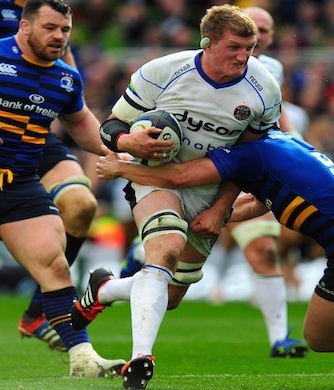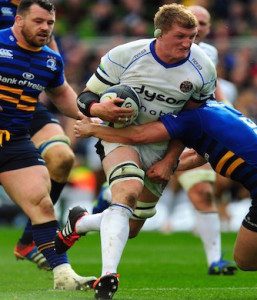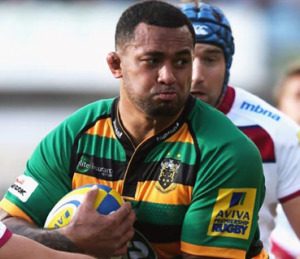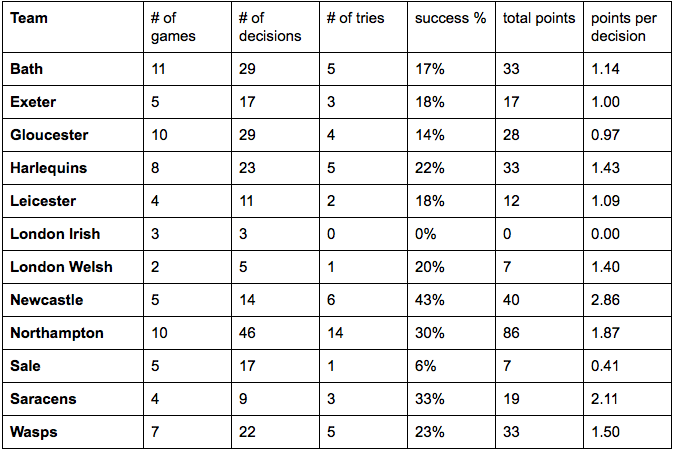
Philadelphia, PA – Need… More… Data… Are teams using Rugby Data gaining Expected Outcomes or Blown Opportunities? Let’s take a look.
On Saturday in Dublin there was a chance late for Bath to put the ball into the corner for a lineout deep in the attacking zone. It was 18-12 to Leinster with 7 minutes left, and Bath took the shot at posts instead of opting for the lineout. That shot turned into 3 points. Good outcome from the penalty or bad?

They lost the game 18-15, so it is easy to think the wrong decision was made. But it is entirely possible that given the circumstances, and even with the outcome of a loss, Bath made the right decision.
How did Stuart Hooper make that decision? As much as feel for the game and instincts matter, we can can also rely on past outcomes to guide how we evaluate such decisions.
Here is the kind of info I am after:
Through 18 rounds of the 2014-2015 Aviva Premiership, I have tracked decisions from penalties in the attacking half for 41 games. For instance, Team A is awarded a penalty 40 meters out and 15 meters in from touch; what do they decide to do with that penalty and what is the outcome?
As the season has progressed, my methodology has improved, I think. At this point, I am trying to track 3 games per round. If I finish the English club season with this pace, I should have data from 56 games when the champion is decided. While understanding that the data is not comprehensive, here is some of what it shows:
Over those 41 games, there have been 226 times when captains opted not to take the shot at posts. That is 5.5 times per game.
The average expected return of the decision to kick to touch, take a quick tap, or take the scrum is 1.4 points. Obviously, that number is going to vary according to team. But the principle seems sound: work out the expected return from different decisions in order to make the best decisions. If a captain can expect his goal-kicker to make a kick from a certain spot 80% of the time, then the expected point value is 2.4. If the decision to kick to touch has an expected point value of 1.4, then the decision seems pretty straight forward.
198 kicks to touch; 20 quick taps; 8 scrums (1 uncontested).
175 opportunities resulted in no points. 50 tries were scored. 44 penalties won. 95 times the ball was, in some way, turned over. There was one drop goal.
That means that teams were, on average, almost twice as likely to turn the ball over than to score a try. However, if the tries are combined with the penalties won, then the outcome is positive as often as negative.
If the attacking team won a penalty, that does not, in this tally, count as success. Each new penalty was treated as its own event.
Here is a breakdown by team:
The first number from the team breakdown that jumps out is Newcastle. The Falcons in the games I logged had the highest rate of success. That’s a bit of a head-scratcher.
The other thing that stands out is Northampton’s rate of foregoing goal-kicking opportunities. Because I tracked 10 games for each, I took a closer look at Gloucester and Northampton. My initial assumption was that Northampton would have created more opportunities. They are the best team in the league, so teams are more likely to commit penalties in defense. That was my thinking. However, looking at the 10 games in question, Gloucester’s opponents conceded 75 penalties in Gloucester’s attacking half. Northampton’s opponents conceded 73 penalties in Northampton’s attacking half. Using this sample for comparison, Gloucester actually created more pressure and more penalty opportunities. Gloucester opted for the kick at goal 46 times; Northampton 27. Their decision making is almost completely flipped. Over almost the same number of chances, Northampton scored 10 more tries than Gloucester.

Northampton is more aggressive in their decision-making, and they are successful. It is not surprising that a team’s ability to convert pressure into points is correlated with winning, but this is a stark contrast.
One of the things I expected was that many of the decisions to kick to touch would be made by teams whose hope of winning the game through patient pressure was already really gone. At the start of the season, I did not consistently take note of the score at the time of the decision. However, for the decisions when the score was known, the average point difference was -2.5. Yes, teams losing were more likely to pass up the shot at posts, but the difference is smaller than I expected. 94 times, the decision was made by the team trailing. For 59 of the decisions, the difference in score was 3 points or fewer. For 74 decisions, the team making the decision was leading.
The more data I collect and the more closely I look at it, the more questions I have. Like: What teams gain the most territory through kicks to touch?
I am now noting the location of not only the spot of the penalty, but also the lineout if the team kicks to touch. With this information, it is possible to start understanding which teams are gaining the most territory from penalties. To really know, data from every penalty needs to be collected, not just those in the attacking half.
The average kick (from my data sample) gains 13.6 meters of territory. That is artificially low because of the times teams kick to touch from a penalty only 5 meters from the try line. If only kicks taken 20 meters out and further are considered (33 kicks), the average goes up to 22 meters. If only kicks taken 30 meters out and farther (27 kicks), the average goes up to 22.5. 40 and farther (14), 26.2.
Data like this adds another, pretty simple, way to measure players’ value to their teams – relative to other performers. We already want to talk about these things. We might as well have some good fuel for these discussions. I don’t have the breakdown by player for territory gained through kicks to touch. Maybe at the the end of the season.
Also on the optimistic to-do list for the end of the season is to link decisions together so we can see which penalties led to another penalty which led to points.
More questions: Is a team more likely to score a try from a 5 meter lineout than a 10 meter lineout? If yes, then we can place a value of those meters gained by the kick to touch.
Little by little, we can improve the way we think about and talk about player and team performance.
That’s it for now. Feel free to add your thoughts below, please look for and “Like” our Facebook Rugby Wrap Up Page and follow us on Twitter@: RugbyWrapUp, Jake Frechette, Junoir Blaber, James Harrington, Jamie Wall, Nick Hall, DJ Eberle, Scheenagh Harrington, Jamie Loyd, Cody Kuxmann, Karen Ritter, Audrey Youn, Akweley Okine and Declan Yeats, respectively.


